COOPERATION MODEL
ARTIFICIAL INTELLIGENCE
PRODUCT ENGINEERING
DevOps & Cloud
LOW-CODE/NO-CODE DEVELOPMENT
INDUSTRY
FRONTEND DEVELOPMENT
CLOUD DEVELOPMENT
MOBILE APP DEVELOPMENT
LOW CODE/ NO CODE DEVELOPMENT
EMERGING TECHNOLOGIES







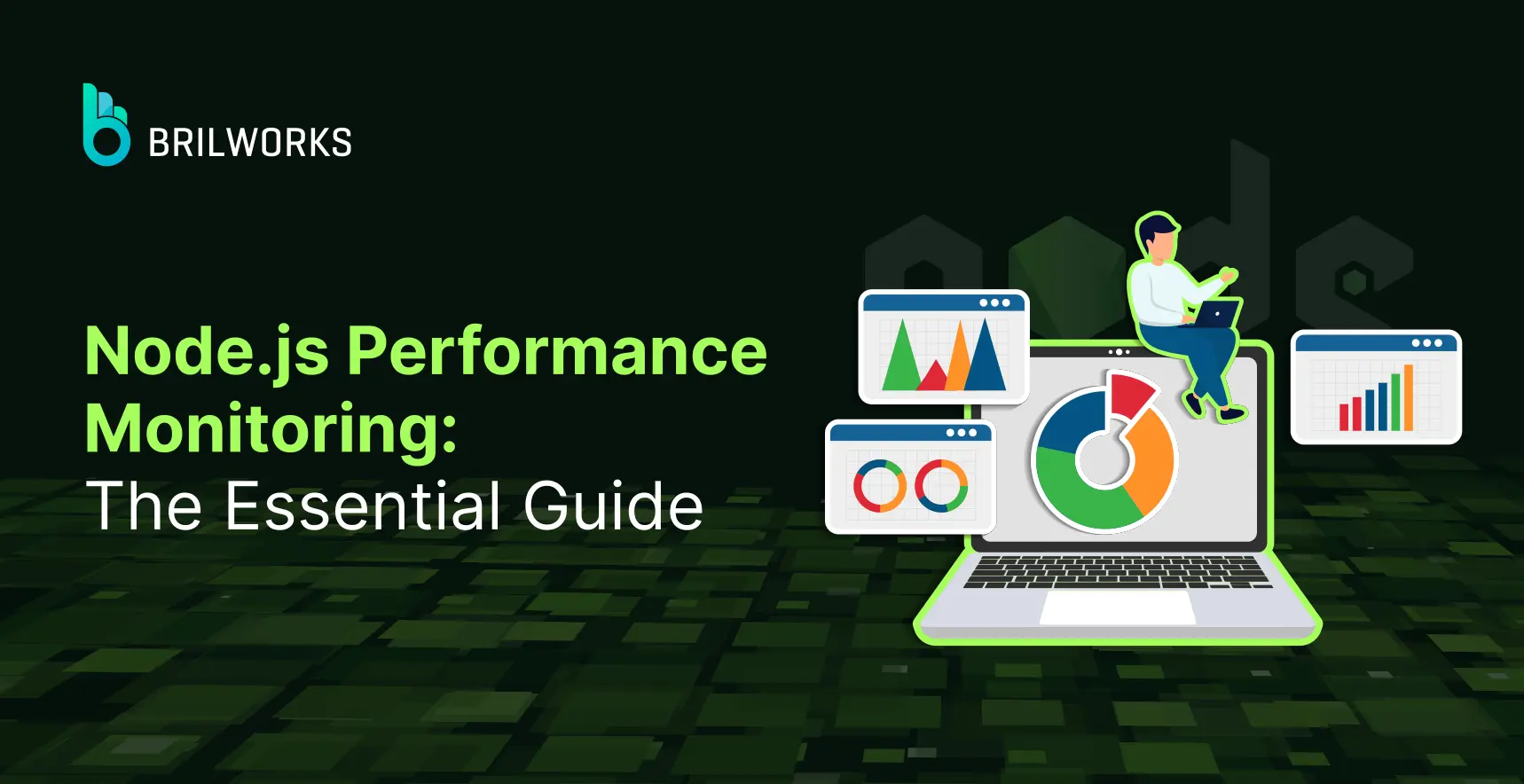
Node.js executes JavaScript code in a single thread. It leverages an event loop and asynchronous I/O operations to manage multiple requests concurrently. However, the dynamic nature of JavaScript and the asynchronous programming paradigm can increase the potential for memory leaks and high CPU loads if not appropriately monitored. This is where performance monitoring comes in.
However, some developers might overlook it due to time constraints or lack of awareness, or many rely only on built-in tools, skipping a proper monitoring approach for complete visibility into their application's health.
While some developers may downplay the importance of performance monitoring, ignoring it can have substantial long-term repercussions.
Are you interested in learning about Node.js performance monitoring and the best practices for its implementation? This article will provide a comprehensive guide and introduce various tools to take your monitoring efforts to the next level.
Are you struggling to identify bottlenecks that are affecting your application's speed and responsiveness? Get a free consultation to discuss your specific challenges and learn how our Node.js performance monitoring solutions can help you optimize your application for improved performance and user experience.
As functionalities expand and user bases grow, performance inevitably becomes a concern. Effective monitoring allows you to keep an eye on emerging bottlenecks before they escalate into user-facing problems.
Moreover, this practice helps you identify optimization opportunities within your Node.js application if your application is working smoothly.
You might be here for two reasons: either wrestling with performance challenges or aiming to enhance your app's performance analysis across various conditions. If you fall into either camp, keep reading to explore effective performance monitoring techniques.
Node.js monitoring refers to the process of tracking and analyzing the performance, behavior, and health of Node.js applications in real-time or over a period of time. This involves collecting various metrics and data points related to the application's runtime environment, such as CPU usage, memory consumption, event loop activity, request latency, error rates, etc.
It typically involves using specialized tools and software solutions designed to capture, aggregate, and visualize performance data.
These tools help developers and system administrators gain insights into the internal workings of Node.js applications, allowing them to identify performance bottlenecks, diagnose issues, optimize resource usage, and ensure the application's overall reliability and scalability.
There are commonly used approaches and tools for monitoring Node.js performance. By following these guidelines, you can establish effective performance monitoring practices for your Node.js applications, ensuring optimal performance, reliability, and scalability in production environments.
Professional developers take a multifaceted approach to application performance monitoring, utilizing various tools and strategies to comprehensively understand their application's performance and health.
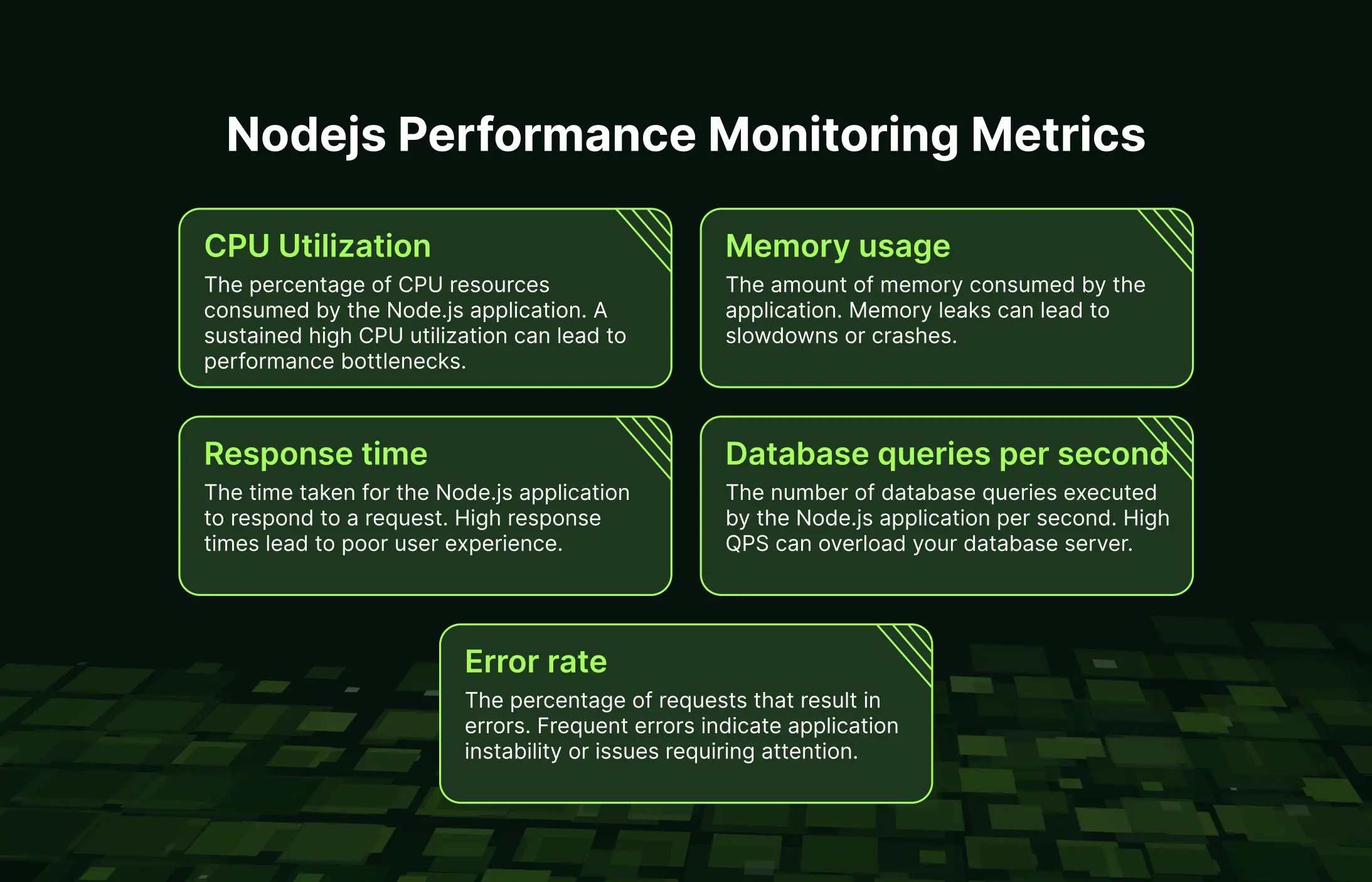
Begin the process by gathering metrics, which are quantitative measurements that reflect particular aspects of a system or process. In Node.js performance monitoring, metrics could include:
The percentage of CPU resources consumed by the Node.js application. A sustained high CPU utilization can lead to performance bottlenecks.
The amount of memory consumed by the application. Memory leaks can lead to slowdowns or crashes.
The time taken for the Node.js application to respond to a request. High response times lead to poor user experience.
The number of database queries executed by the Node.js application per second. High QPS can overload your database server.
The percentage of requests that result in errors. Frequent errors indicate application instability or issues requiring attention.
Additionally, you can collect several other metrics using various tools designed specifically for performance monitoring purposes. The choice of the right tools depends on your specific needs and goals.
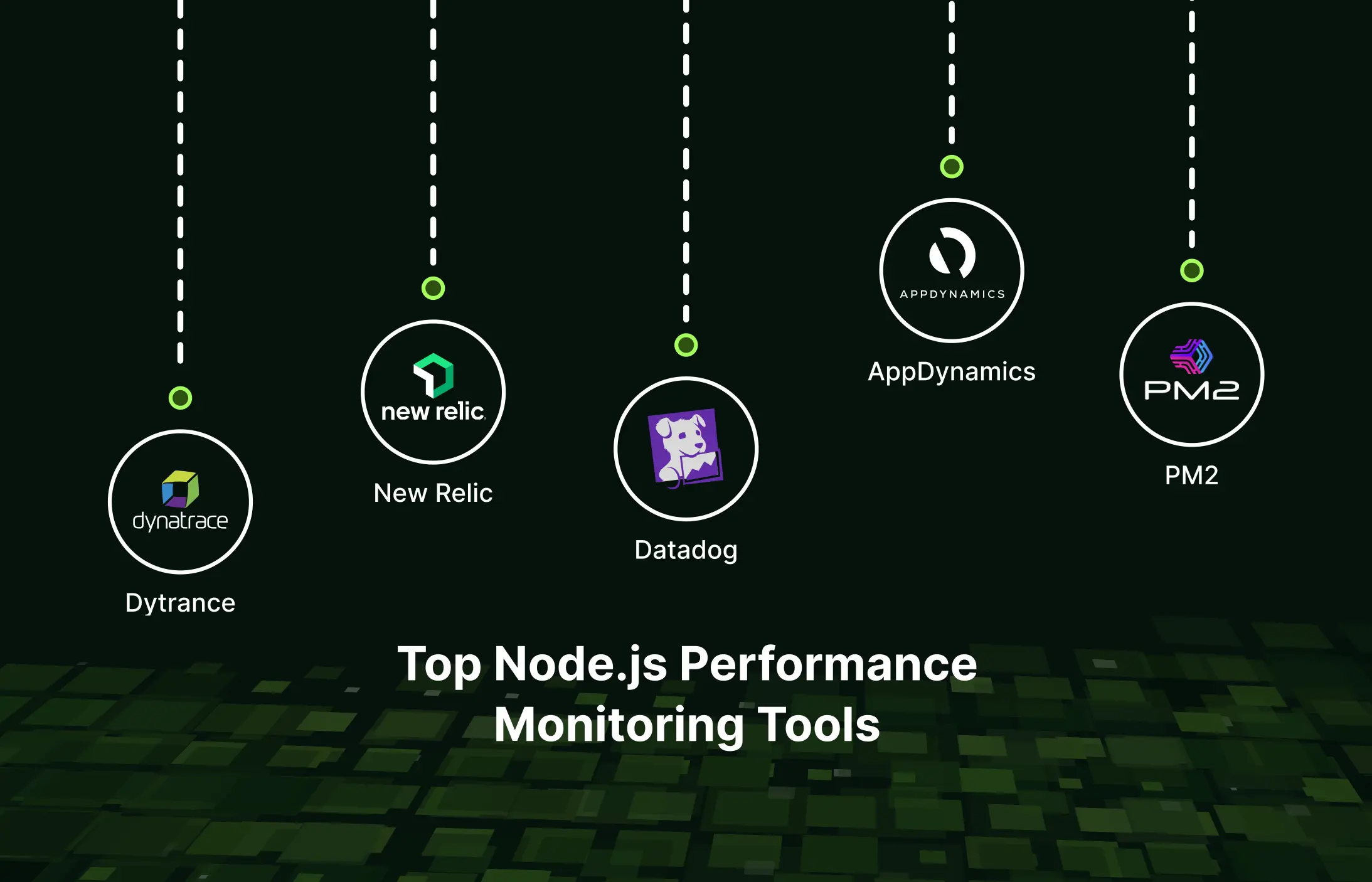
There are several tools available in the market, each offering a different set of features for various types of testing, including performance monitoring. Below are some standard tools used for performance monitoring.
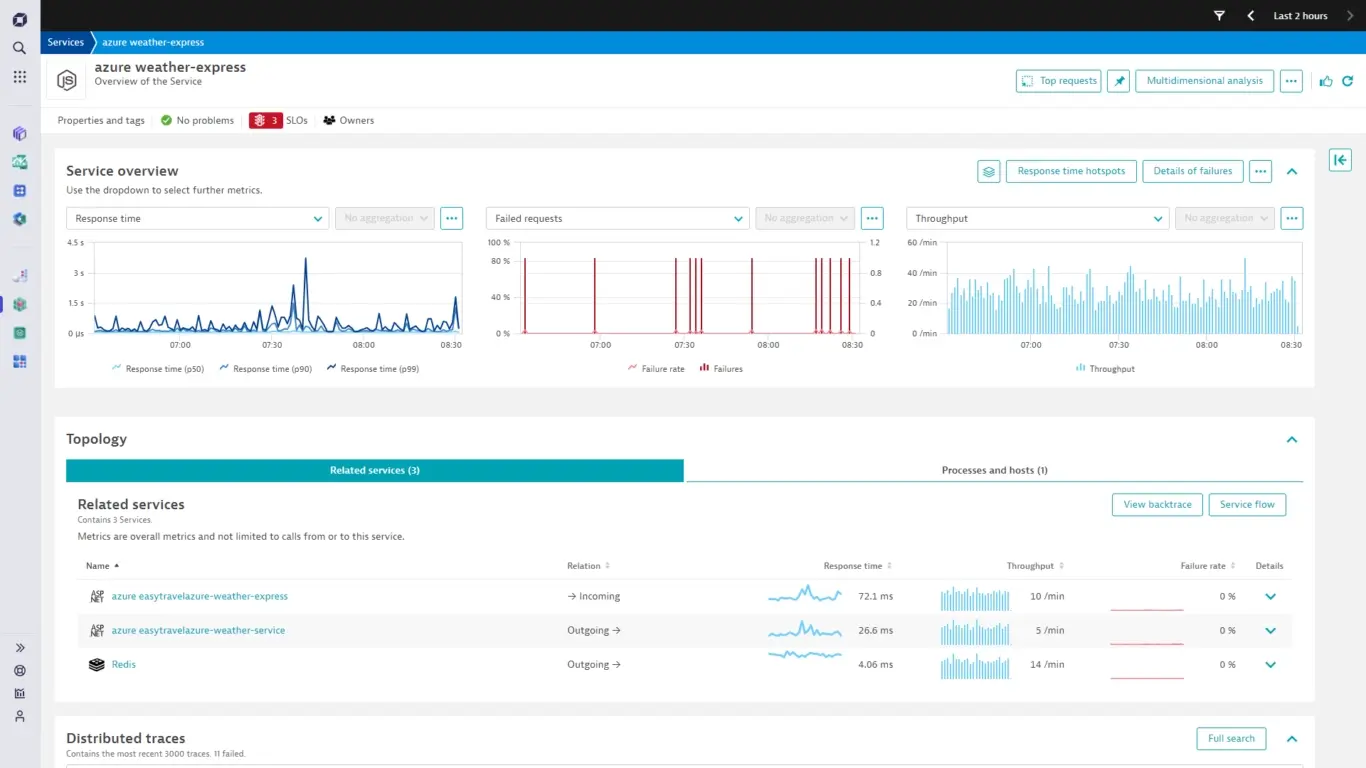
Dynatrace provides automatic and comprehensive monitoring for node.js applications. It gives you complete visibility of your application'sapplication's performance, user experience, and infrastructure health.
In addition, it offers support for popular Node.js frameworks and modules, including Express, Restify, HTTP, Connect, and Request.
Key features:
Server-side requests tracking
Code-level tracking
Heap memory monitoring
Suspension metrics
Event loop metrics
Response time analysis
Real-users and synthetic monitoring
Automatic application monitoring

AppMetrics is an open-source, cross-platform library designed for real-time application monitoring and an excellent option for resource-constrained applications. It offers various metric tracking options, including response time, error rates, and resource utilization.
The metrics it provides can be reported to the desired repository, all while minimizing the impact on your application'sapplication's performance.
It is built to offer an easy way to capture desired metrics within an application. Its customizable dashboard lets you track only what matters to you most.
Key features:
Open-Source and Cross-Platform
Support for Various Metric Types
Automatic Performance Measurement
Flexible Persistence and Visualization
Support for Push and Pull-Based Metrics Collection
Ease of Use and Flexibility
Custom Endpoint Support

DataDog APM is a feature-rich Nodejs monitoring tool that helps users analyze stack traces and track metrics to ensure service level agreements are met.
It offers features like Service Map for visualizing affected services, App Analytics for troubleshooting, and Log Patterns for error tracking. Built-in support for Node.js frameworks and libraries simplifies app instrumentation and identifies slow queries.
Datadog APM unifies monitoring tools and intuitive performance analytics for Node.js applications.
Key features
Real-time monitoring with customizable dashboards.
Detailed process monitoring.
Built-in integrations with popular Node.js frameworks and libraries.
Anomaly detection and alerting.
Distributed tracing and APM capabilities.
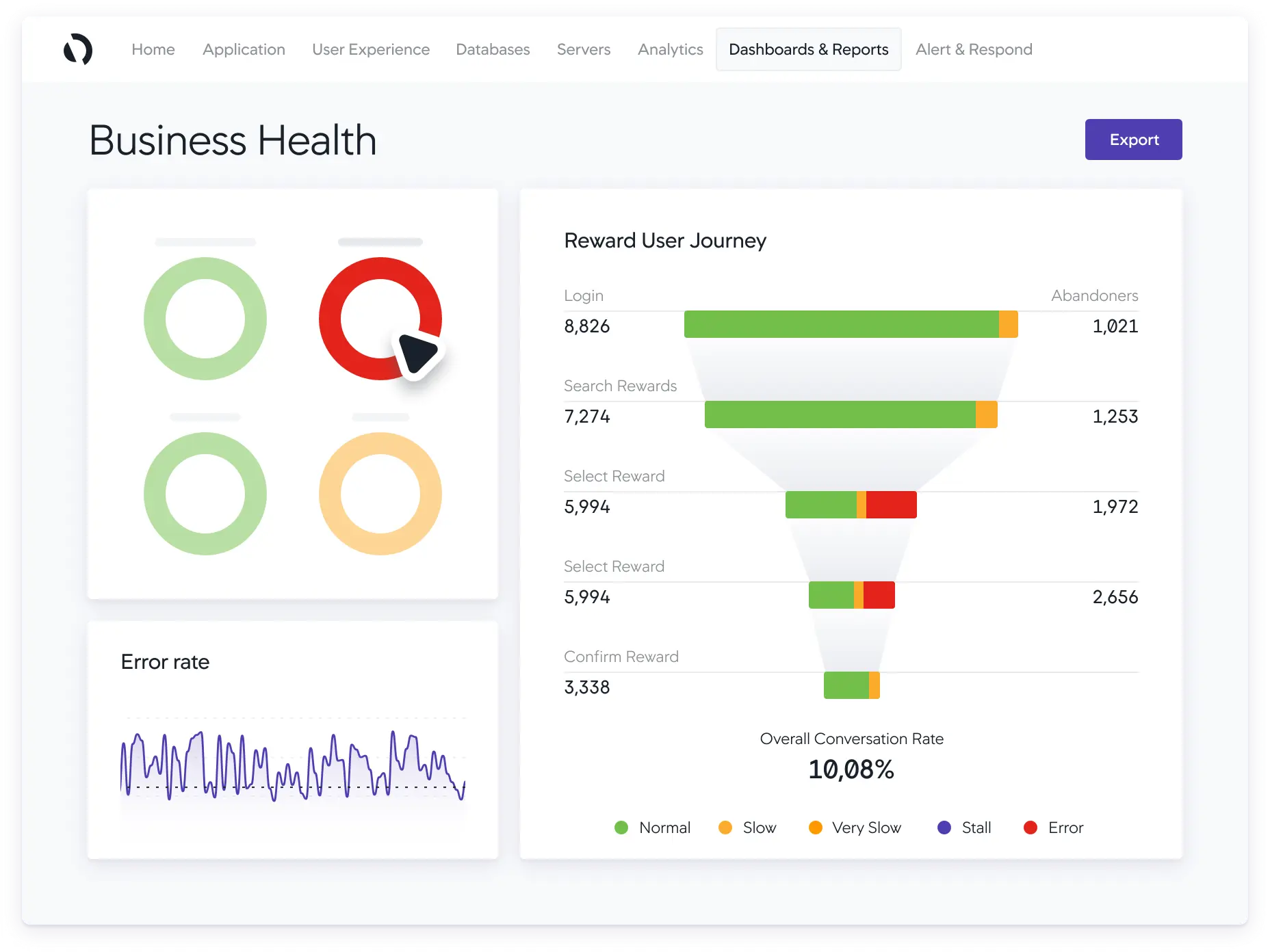
AppDynamics offers end-to-end Node.js Application Performance Monitoring, providing visibility into metrics and business transactions.
Features like auto-discovered Business Transactions, dynamic baselining, and code-level diagnostics ensure rapid issue identification and resolution in complex environments.
Users can drill down into process call graphs, correlate transactions, and diagnose memory leaks, CPU problems, and performance bottlenecks.
Flame graphs visualize code execution, while allocation snapshots aid in diagnosing memory leaks. Furthermore, it supports various frameworks, including Derby, Koa, Express, and more.
Flame graphs to visualize the execution of your Node.js application code
Real-time performance monitoring and diagnostics.
Automatic discovery and mapping of application dependencies.
Code-level visibility and transaction tracing.
Business transaction monitoring for tracking user interactions.
Integration with other monitoring and alerting tools.
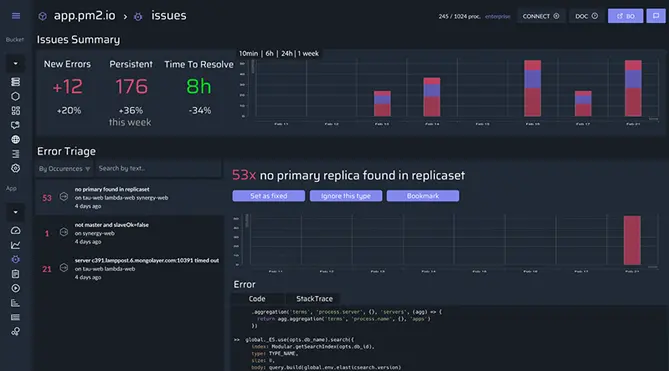
PM2 is a simple process manager for Node.js applications that allows the running and monitoring Node.js applications at the command line. It is installable via NPM or Yarn.
Additionally, it supports cluster mode for Node.js applications and allows for ecosystem file configuration to manage multiple applications. PM2 also facilitates setting up startup scripts and restarting applications after file changes.
Key Features:
Real-time Monitoring
Issues & Exception Tracking
Deployment reporting
Real-time logs
Email & Slack notifications
Custom Metrics Monitoring
Custom Actions Center
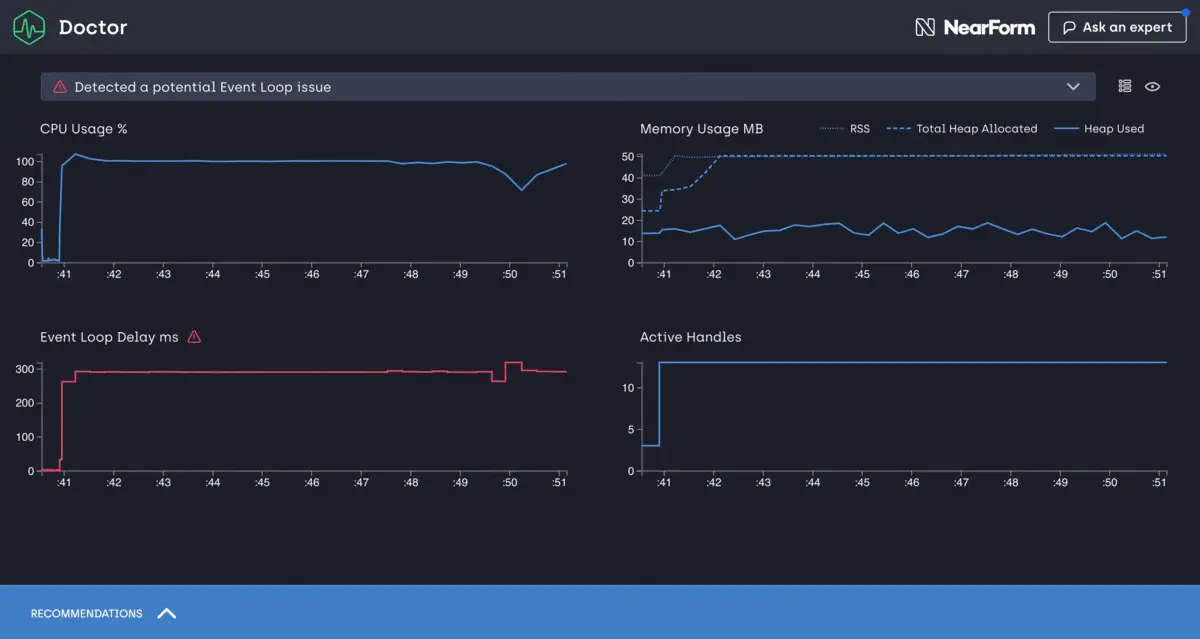
Clinic.js offers a suite of tools designed to diagnose and pinpoint Node.js performance issues. These tools include Bubbleprof for profiling, Flame for displaying bottlenecks and hot paths with flame graphs, and HeapProfiler for identifying memory allocation by function.
Each tool collects metrics, assesses health, and provides recommendations to optimize Node.js applications effectively.
Key features:
Metrics collection
Performance assessment
Data visualization
Latency tracking
Memory profiling
Async Hooks integration
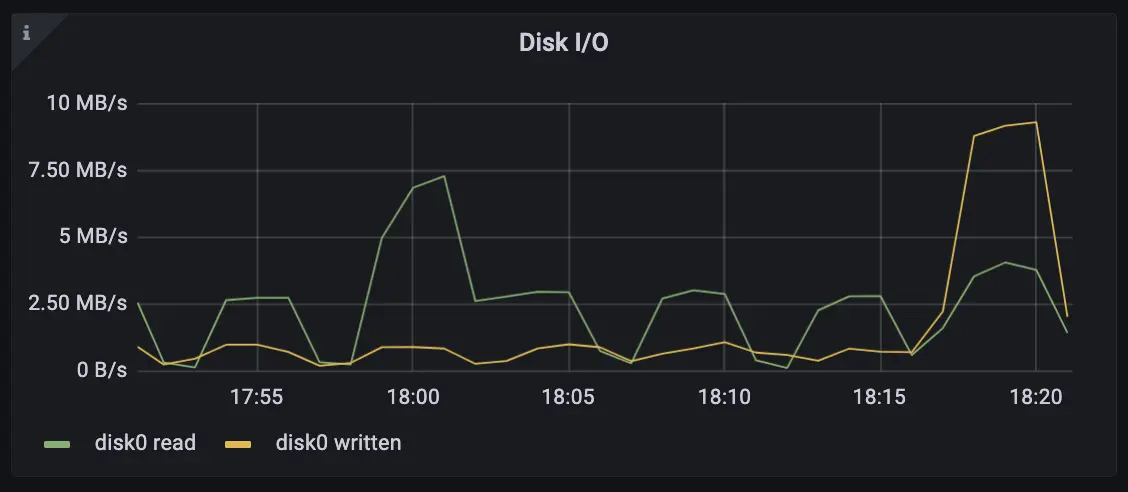
Prometheus is an open-source monitoring system created by SoundCloud in 2012, with a powerful query language and flexible alerting mechanism. When combined with Grafana, it provides visualization and dashboarding capabilities.
Key features:
A multi-dimensional data model with time series data identified by metric name and key/value pairs
PromQL, a flexible query language to leverage this dimensionality
No reliance on distributed storage; single server nodes are autonomous
Time series collection happens via a pull model over HTTP
Pushing time series is supported via an intermediary gateway
Targets are discovered via service discovery or static configuration
Multiple modes of graphing and dashboarding support
In summary, Node.js applications require proper performance monitoring to ensure optimal functionality and user experience. Several tools are available in the market to monitor performance effectively and proactively identify and address potential bottlenecks.
Do you want to gain deeper insight into your Node.js application's performance? With Brilworks, you can optimize its performance and ensure seamless operations. Hire our team of skilled Node.js developers today, and let's work together to enhance your app's performance and exceed your users' expectations.
1. Why is Node.js performance monitoring important?
While Node.js is known for its asynchronous capabilities, its dynamic nature and reliance on JavaScript can lead to performance bottlenecks if not monitored. Performance monitoring helps you identify and address these issues before they impact user experience and scalability.
2. What are some key metrics to track for Node.js performance?
Essential metrics include CPU utilization, memory usage, response time, database queries per second, and error rate. Each metrics reveal different aspects of your application's health, allowing you to pinpoint bottlenecks and optimize resource usage.
3. What are some popular Nodejs performance monitoring tools?
Several tools offer different features and functionalities. Some popular tools include AppMetics, Clinic.js, PM2, DataDog APM, Dytrance.
4. How can I get started with Node.js performance monitoring?
If you need expert guidance, consider hiring experienced Node.js developers. Our team at Brilworks can help you implement best practices, select the right tools, and ensure your Node.js application delivers optimal performance for your users.
Get In Touch
Contact us for your software development requirements
Get In Touch
Contact us for your software development requirements